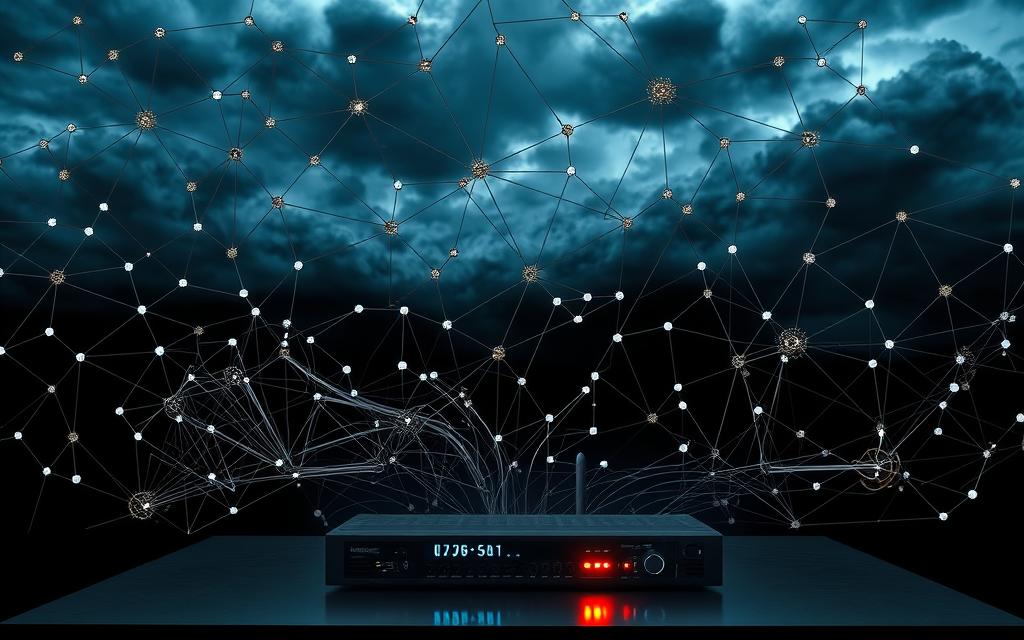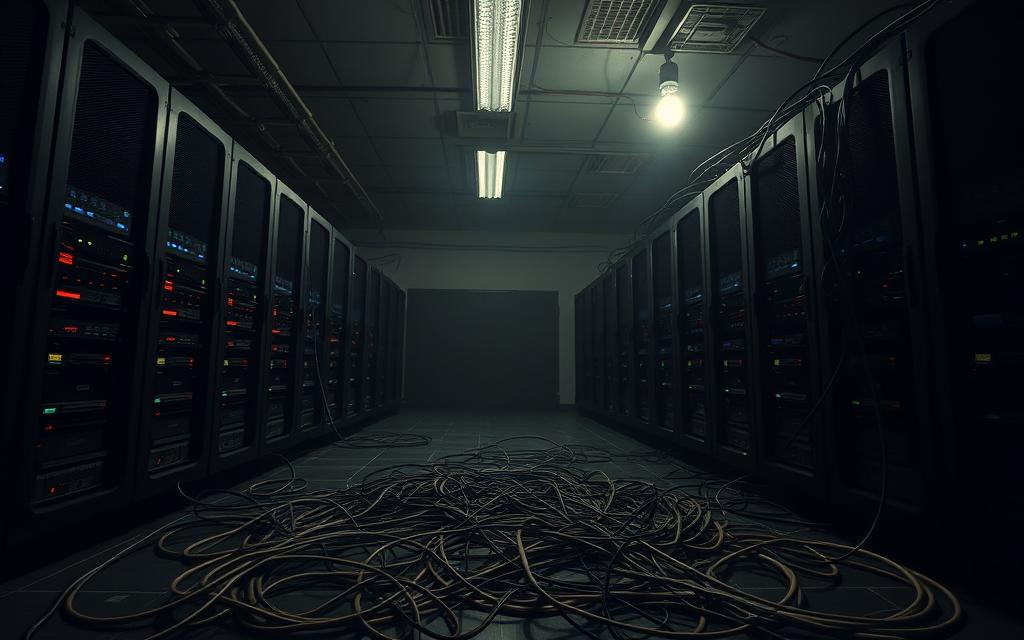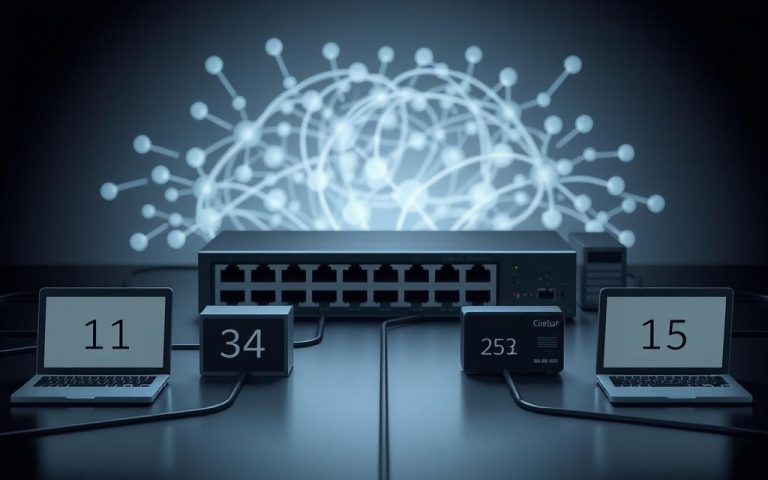The Downsides of Computer Networks: Risks & Limitations
Computer networks have revolutionised global communication, enabling unparalleled connectivity and resource sharing. However, these complex systems come with significant drawbacks that organisations must navigate carefully1.
Businesses heavily depend on networked infrastructure, yet face substantial risks. Cyber attacks target 43% of small businesses, exposing digital ecosystems’ vulnerabilities1. Connected devices have a 70% chance of virus transmission1.
Network limitations go beyond security issues. Companies face productivity disruptions and financial consequences. Network-related distractions cause a 20% drop in productivity1. Network downtime costs businesses an estimated £4,400 per minute1.
Grasping these complexities is vital for organisations. This detailed network analysis explores computer network vulnerabilities, offering insights into risk mitigation.
Modern digital infrastructure’s interconnected nature requires robust strategies. These strategies address network risks and minimise potential disruptions2.
Understanding Computer Networks and Their Core Functions
Computer networks are vital for modern communication. They allow devices to share resources seamlessly. These systems connect everything from small offices to global networks.
Network types have changed how organisations work. They range from simple two-device connections to vast global systems. These networks link billions of devices worldwide.
Exploring Network Types
Different network types serve unique purposes in our digital ecosystem:
- Local Area Networks (LANs): Interconnect devices within a single domain3
- Wide Area Networks (WANs): Connect multiple networks across broader geographical regions3
- Metropolitan Area Networks (MANs): Link resources within city boundaries3
- Personal Area Networks (PANs): Connect individual devices for personal use3
Network Infrastructure Components
A strong network needs key parts like routers, switches, and servers. These work together to send data and manage the network efficiently.
Modern enterprises rely on sophisticated network architectures to maintain seamless communication and resource accessibility.
Data Flow Mechanisms
Data moves through networks using complex protocols. The TCP/IP model is a key framework for this communication. It ensures data moves reliably across different network types.
Network capacity is measured in bandwidth. It determines how fast data can move. Advanced networks use various protocols to work better and more reliably.
What are the disadvantages of using a computer network?
Computer networks are powerful tools, but they come with significant drawbacks. Organisations face many challenges when using networked systems. These range from security risks to operational complexities4.

- Substantial security vulnerabilities4
- High implementation and maintenance costs5
- Potential for widespread system failures4
- Increased exposure to cyberattacks5
Network challenges are clear when looking at the financial impact. Building a network can cost 20-30% more than standalone machines. Support expenses can increase by 15-25%5.
The average data breach in a networked setting can cost about £3 million. This shows the hefty financial risks involved4.
| Network Challenge | Potential Impact |
|---|---|
| Security Breaches | 60% of businesses experience vulnerabilities4 |
| Operational Downtime | Up to 100% network operations can halt during server failures5 |
| Malware Spread | 10-100 times faster transmission compared to standalone systems5 |
Despite these drawbacks, organisations still adopt networks for their collaborative benefits. Careful planning and robust security measures can help reduce many of these risks4.
Managing network infrastructure requires specialised technical expertise and continuous vigilance.
Security Threats and Vulnerabilities in Networked Systems
Computer networks face complex security threats that can compromise organisational integrity and data protection. Cyber criminals develop sophisticated attack strategies to exploit vulnerabilities across digital infrastructures. Organisations must stay vigilant to protect their digital assets6.
The digital ecosystem presents multiple cyber attack vectors for organisations to defend against. Cybersecurity has become a critical battleground where prevention and proactive management are crucial7.
Common Cyber Attack Mechanisms
- Phishing attacks targeting employee vulnerabilities6
- Ransomware targeting critical infrastructure6
- Distributed Denial of Service (DDoS) disruptions7
- Zero-day software exploits6
“Security is not a product, but a process” – Bruce Schneier
Data Breach Implications
Data breaches can be devastating for organisations. Potential consequences include financial losses of around £3.4 million per incident. They can also cause significant reputational damage and legal ramifications7.
Surprisingly, 43% of cyberattacks specifically target small businesses. This statistic shows how widespread these threats are6.
Network Security Best Practices
- Implement robust firewall protection
- Conduct regular security audits
- Provide comprehensive staff training6
- Deploy multi-factor authentication
- Maintain up-to-date patch management7
Organisations must recognise that 95% of successful cyberattacks involve human error. This fact highlights the importance of continuous education and awareness6.
Cost Implications and Resource Management
Computer networks are a major financial investment for organisations. They require careful planning for both initial and ongoing expenses. Costs can rise significantly as data storage needs grow.
- Initial hardware procurement
- Software licensing
- Network maintenance expenses
- Specialised staff recruitment
Network monitoring costs vary based on organisational needs. Companies must evaluate pricing models to optimise their tech investments. Different pricing strategies include:
| Pricing Model | Cost Implications |
|---|---|
| Per-device | Potential rapid cost increase with scaling |
| Per-user | Predictable pricing for static environments |
| Tiered | Flexible but potentially expensive |
Cloud storage and processing often prove more cost-effective than physical hardware8. Strategic planning is vital to avoid unexpected maintenance costs. This approach ensures efficient resource allocation.
Effective network management requires balancing technological needs with financial constraints.
Organisations should assess their network infrastructure thoroughly. They must consider long-term scalability and future tech needs9. Investing in robust monitoring systems can reduce risks and lower operational costs9.
Technical Limitations and Performance Issues
Computer networks face many technical challenges. These affect their performance and reliability. Such limitations create complex obstacles for organisations seeking smooth digital communication.
Modern networks encounter several critical performance issues. Network bandwidth limitations are a primary concern. Organisations face substantial connectivity challenges10.
Bandwidth saturation affects up to 80% of networks during peak times. This creates significant operational bottlenecks10.
Key Network Performance Challenges
- Bandwidth constraints reducing data transfer speeds
- Network latency issues impacting real-time applications
- Scalability problems limiting network expansion
Network latency issues can dramatically influence system performance. Latency can increase by 20-30% during high traffic periods. This directly affects user experience and application responsiveness10.
Organisations must proactively address these challenges to maintain optimal network functionality. Scalability problems represent another significant technical limitation. Large networks often struggle to maintain consistent performance as connections increase.
Improper host identification can escalate troubleshooting time by 50%. This complicates network management efforts10.
Effective network management requires continuous monitoring and strategic infrastructure planning.
Hardware performance plays a crucial role in network reliability. Faulty equipment can reduce data transmission speeds by 25%10. Proactive maintenance and regular system updates are essential strategies.
Performance Monitoring Strategies
- Implement continuous network monitoring
- Regularly assess bandwidth utilisation
- Update network infrastructure components
- Conduct periodic performance audits
Understanding network bandwidth, latency, and scalability issues is crucial. By addressing these, organisations can develop robust digital communication infrastructures. This supports seamless operational efficiency.
Impact on Productivity and User Experience
Computer networks offer great teamwork potential but also bring distractions that can harm workplace efficiency11. Studies show 40% of staff say poor network performance hinders their task completion11.
The user experience in networked settings depends on three key factors:
- Network performance and speed
- Security reliability
- Connectivity stability
Network issues can slash productivity by up to 70%12. Frequent connection problems may lower job satisfaction and boost staff turnover by 30%12. These disruptions create digital friction that hampers workplace output.
System latency is a major worry, causing delays in file access and communication12. Strong network setups can boost productivity by 25% through better communication tools11.
The answer lies in smart network management that cuts disruptions and boosts teamwork. This approach can help create network performance optimisation.
By tackling these network issues, companies can build more robust and efficient digital workspaces.
Conclusion
Balancing network pros and cons requires a strategic approach to computer network technologies. Networks provide crucial connectivity but also present significant risks that organisations must manage. Security threats demand constant vigilance and robust mitigation strategies1314.
Mitigating network disadvantages involves implementing comprehensive security protocols and recognising performance limitations. Research shows 85% of companies face security incidents yearly. Data breaches can cost businesses millions and threaten their stability14.
The future of network technology is bright, with emerging solutions addressing current issues. Advanced security, edge computing, and sophisticated architectures are evolving to tackle existing challenges. Strategic investment in infrastructure and staff training will be crucial1314.
Organisations must stay agile as digital landscapes change. They should embrace innovative solutions whilst maintaining a balanced view of network technologies’ complexities. This approach will help maximise potential and minimise risks in the evolving digital world.
FAQ
What are the primary security risks associated with computer networks?
How expensive are computer networks to implement and maintain?
What technical limitations might affect network performance?
How do computer networks impact workplace productivity?
What are the different types of computer networks?
How can organisations mitigate network security risks?
What infrastructure components are essential for computer networks?
How do cyber attacks spread across networked systems?
What are the primary challenges in network management?
How do networks handle data transmission?
Source Links
- https://unstop.com/blog/advantages-disadvantages-of-computer-network
- https://www.studysmarter.co.uk/explanations/computer-science/computer-network/
- https://www.techtarget.com/searchnetworking/definition/network
- https://www.educba.com/computer-network-advantages-and-disadvantage/
- https://theteacher.info/index.php/fundamentals-of-computer-networks/notes/5436-benefits-and-risks-of-computer-networks
- https://nordlayer.com/learn/network-security/threats/
- https://www.imperva.com/learn/application-security/network-security/
- https://greenprofitsolutions.com/blog/pros-cons-data-management-systems-financial-institutions-credit-unions/
- https://www.ninjaone.com/blog/how-much-does-network-monitoring-cost-software-pricing/
- https://www.tutorialspoint.com/what-are-the-challenges-of-a-computer-network
- https://www.vaia.com/en-us/explanations/computer-science/computer-network/
- https://crisptechnology.com/15-major-disadvantages-of-computer-networking/
- https://www.techjockey.com/blog/advantages-and-disadvantages-of-computer-networking?srsltid=AfmBOop7cPcP66YCLtghRF8Xcqm820G3Wbj2Y88Y0xKj1KQ8FfAjr5vI
- https://www.prepbytes.com/blog/computer-network/pros-and-cons-of-computer-networking/







